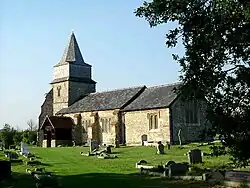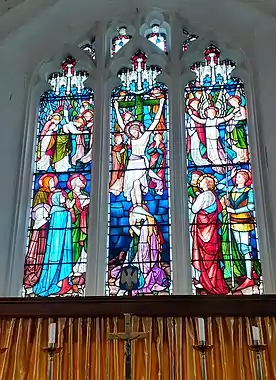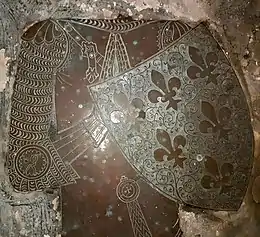Church of St Margaret, Bowers Gifford
The Church of St Margaret is a 14th-century grade II listed church near Bowers Gifford, Essex.[1]
| Church of St Margaret | |
|---|---|
 | |
| 51.556828°N 00.531563°E | |
| Denomination | Church of England |
| Website | St Margaret's Church |
| History | |
| Founded | 1350 |
| Founder(s) | Sir John Giffard |
| Dedication | Margaret the Virgin |
| Dedicated | 27 December 1292 |
| Associated people | Sir John Giffard Knight |
| Architecture | |
| Functional status | Parish church |
| Heritage designation | Grade II* |
| Designated | 4 July 1955[1] |
| Architectural type | Church |
| Administration | |
| Diocese | Chelmsford[2] |
| Parish | Bowers Gifford with North Benfleet[2] |
| Clergy | |
| Vicar(s) | Rev David Ibiayo |
The church is notable for its surrounding fields and marshland and its adjacency to the main C2C railway line to London.[3]
As is common with many Essex churches, it features a wooden bell-cot surmounting a stone tower.[4]
Location
The church is two miles east of Basildon in south Essex, separated from the River Thames by Canvey Island. Originally the church served a remote village surrounded by estuary marshes, as a result of this the church sits 10 meters above sea level.
History

In 1086, the Domesday Book stated Bowers Gifford had four landholders, four ploughs, and sheep.[5] A wooden Saxon church stood at that time.
St Margaret's Church dates back to 1350; officially the Church is known as St Margaret's of Antioch.
Exterior history
A two-stage stone tower is supported by a heavy diagonal buttress on the south west corner. On the south west side is a semi-circular relieving arch and a south nave with side buttresses. The nave has four windows dating from the 15th century, a crypt is beneath the church, not having been opened for two centuries.
The western bell tower and steeple were built in the early 16th century, and over the following centuries the church fell into a state of neglect, and during the 18th century was used as a barn. The church structure came under a major restoration program between 1867 and 1870. The south porch was added in 1910, and in 1923 and 1930 further restorations took place, Restoration architects J. Peacock and Sir Charles Nicholson were responsible. The most recent restoration took place in 2000 when the steeple was renovated and reclad with cedar shingles.
Interior history
Some features of the interior include:
- A square plaster panel in nave south wall depicting Virgin and Child, 14th century.
- A double wave-molded tower arch with an early 16th-century timber frame, a steeple frame which consists of four heavy oak square posts and a heavy middle rail, which are cross-braced.
- A nave and chancel in form of a canted and boarded barrel roof, with molded and transverse ribs. Eastern two bays over the altar elaborated with cusped and decorated cross braces.
- A 17th-century pyramid font cover, and a hexagonal pulpit donated in 1924 from Harrow School Chapel, dated 1857.
- Chancel stalls dated 1926, pews in nave dated 1929-1931, and a timber altar rail dated 1941.
Church grounds and construction
St Margaret is built in the Perpendicular style, consisting of a chancel (21ft by 19ft) and nave (40ft by 18ft), south porch, and western tower (10ft square).
St Margaret's is built from Kentish Ragstone rubble, with flint and Roman brick, the dressings are in Reigate stone, and the roofs covered in slate.
The west tower is from the early 16th century , and was built in two stages. Surmounted by a timber superstructure, the low octagonal spire was added in the Tudor period and is clad in cedar wooden shingles.
The west tower has three bells, which can be reached by climbing 25 steps. The bells themselves date to 1380 by William Burford,[6] and are inscribed "Sit Nomen Domini Benedictum", the second bell dated 1400 by Robert Burford[6] is inscribed "Sancta Katerina Ora Pro Nobis", and are some of the oldest in Essex, and are still rung regularly.
Sir John Giffard and the Giffard family
The first mention of the Giffard family in Bowers Gifford was in 1242 when William de la Dune and his wife granted William Giffard land in the village and its marshes. William Giffard was a direct descendant of William the Conqueror, he and his heirs became Lords of Essex Marshes. On 27 December 1292, the royal court granted the Giffard family the right to hold a fair on this date, and additional markets every Friday. Finally the right to warren was confirmed.
The Church of St Margaret was built around 1350 by the Giffard family.
Sir John Giffard monumental brass

Set within the church along the north wall of the chancel lies the 7' stone slab and a damaged monumental brass effigy of Sir John Giffard who died in 1348. This brass is of great historic importance and is the earliest monumental brasses known in the whole of Essex apart from one, that of Sir William Fitzralph in Pebmarsh church, circa 1330.
The dimensions are life-size, making Sir John around 6 feet in height, and according to H.W.King Esq[7] in 1845 of the Archaeological Society of Essex, the armor dates to around 1330 due to its design.
Up until the reign of Elizabeth I, the brass was intact, by 1740 the brass monument was gone. The brass was at some point kept in a barn.
Major Spitty of Billericay[7] was a wealthy land owner; by the 1820s St Margaret's Church was under major renovations, the then Church Warden handed over the brass to Major Spitty for safekeeping. Major Spitty had a keen interest in history and archaeology, and contacted and presented the damaged brass to Reverend W.W. Tireman[7] in 1855. Reverend Tireman had the brass restored and mounted on a new artificial slab, the original slab of stone disappeared possibly in the extension phase. By 1898 the whole brass had come loose, one leg becoming detached in two pieces, and was left in the church.
The Council of the Essex Archaeological Society agreed to donate Two Guineas along with donations from church funds and the brass was restored for a second time, this time being brazed together and mounted correctly. It was also agreed to outline the original missing, head, shoulders, leg, and toe onto the stone slab, rather than commissioning replacements; the work was carried out by a Mr. Henry Young of Herongate.
Present day worship and use
St Margaret's is an Anglican church and is open for a weekly service every Sunday at 9 am. The church also holds ceremonies for weddings, baptisms and funerals. A group of volunteers carries out grounds maintenance, church flower arranging, and general upkeep inside the building.
Reverend David Ibiayo is the church minister and is also responsible for St Chad's church in nearby Vange.
References
- "Church of St Margaret". National Heritage List for England. Historic England.
- "Bowers Gifford: St Margaret". The Church of England. Retrieved 15 January 2019.
- "Church by the tracks". BBC. 31 July 2008. Retrieved 15 January 2019.
- "Timber work in churches". Transactions of the Essex Archaeological Society, Volume 4. 1869. p. 99.
- Powell-Smith, Anna. "Open Domesday Bowers [Gifford]". Open Domesday. Anna Powell-Smith. Retrieved 29 July 2023.
- Stuff, Good. "Church of St Margaret, Bowers Gifford and North Benfleet, Essex". britishlistedbuildings.co.uk. Retrieved 2021-08-01.
- "ESAH160". esah160.blogspot.com. Retrieved 2021-08-01.